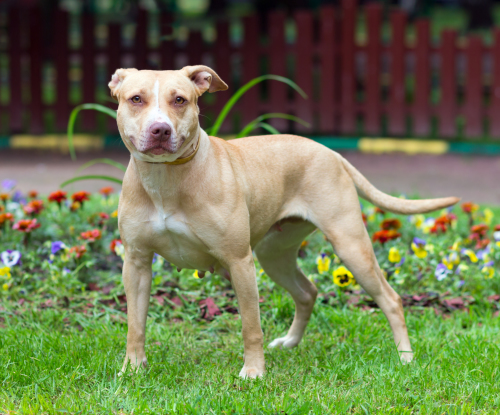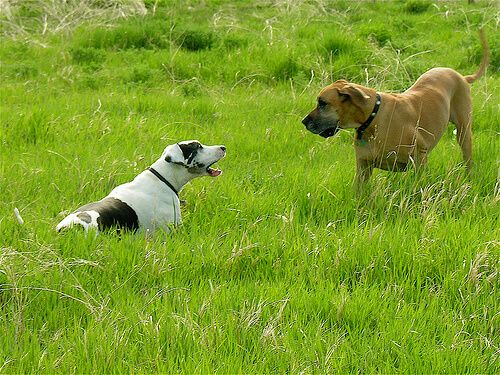Is There Any Such Thing as a Dangerous Dog?

Many experts claim that no breed of dog is inherently dangerous. In fact, it’s often the owners that pose the greatest threat. Whether through abuse or pure irresponsibility, any breed or size of dog can become a danger to both its owners and strangers. However, there are still a great many countries that have drawn up a list of dogs thought to pose a risk to humans.
The dangers of irresponsible or abusive dog owners

When someone adopts or buys a dog, we assume that they are willing to take on the responsibility of not only caring for their new dog, but also of socializing and training them correctly.
Dogs which have been classified as “potentially dangerous” are large, strong breeds which, if they decided to attack, would cause the most serious injuries to humans.
However, in reality, any animal can become dangerous, and it isn’t always due to a lack of training or socialization. A dog can also become aggressive if it suffers from abuse or neglect, including:
- Extreme forms of humanization.
- Leaving it alone to guard the house for extended periods of time.
- Physical abuse such as beating and other forms of punishment.
The debate on whether dangerous dogs really exist, or whether they are merely the result of irresponsible and aggressive dog owners still rages on. Dog experts and behavioral specialists maintain that the true blame for any dog presenting a danger to humans lies for the most part with the owner, and a lack of adequate training and socialization. In some cases, it is also the result of extreme, long-term abuse.
Humans: the real reason dangerous dogs exist
It’s important to recognize that a dog can become aggressive for other reasons. For example, a dog may act aggressively if it’s suffering or in pain (with otitis, hip dysplasia etc.)
We should also mention that dogs, like most members of the animal kingdom, can often display aggressive behavior out of pure instinct. This is most noticeable when they face situations where their survival, or the survival of their young, is at stake.
However, contrary to popular opinion, it’s very unlikely that a dog will inherit aggressive traits from its parents.
So, if an owner refuses to give their dog adequate training, and on top of that, they actually encourage aggressive behavior, then who poses the greatest threat to society?
Everything points towards the fact that in most cases, dangerous dogs aren’t born, they’re made.
What is a potentially dangerous dog?
Each country has its own list of potentially dangerous dogs. These lists include breeds that are likely to cause the most severe injuries to humans if they decided to attack.
The decision of whether or not a dog is considered dangerous is based not only on the size or the type of bite, but also on whether a breed has been used for dangerous practices over the years (guard dogs, hunting dogs, fighting dogs, etc.)
If we take Spain for example, the list of potentially dangerous dogs includes:
- Pit bull terriers
- Staffordshire bull terriers
- American Staffordshire bull terriers
- Rottweilers
- Dogo Argentino
- Brazilian mastiffs
- Tosa Inu
- Akita Inu
Requirements for owning a potentially dangerous dog

However, these laws don’t just take the dog’s breed into account; they also refer to dogs which show certain physical and psychological characteristics. Large, strong, and muscular dogs also fall under the category of potentially dangerous.
In any case, if you want to buy or adopt a dog which falls under this category, there is a series of requirements you’ll have to meet in most countries. Here are some of the more usual requirements:
- Being of legal age
- Not having been charged with any of the following: homicide, assault, torture, crimes against liberty or moral integrity, crimes against sexual freedom or public health, or be associated with any armed gangs or drug traffickers.
- Not being banned from keeping dangerous dogs.
- Being physically and psychologically able to look after a dog.
- Having civil liability insurance for injury to a third party.
Many experts claim that no breed of dog is inherently dangerous. In fact, it’s often the owners that pose the greatest threat. Whether through abuse or pure irresponsibility, any breed or size of dog can become a danger to both its owners and strangers. However, there are still a great many countries that have drawn up a list of dogs thought to pose a risk to humans.
The dangers of irresponsible or abusive dog owners

When someone adopts or buys a dog, we assume that they are willing to take on the responsibility of not only caring for their new dog, but also of socializing and training them correctly.
Dogs which have been classified as “potentially dangerous” are large, strong breeds which, if they decided to attack, would cause the most serious injuries to humans.
However, in reality, any animal can become dangerous, and it isn’t always due to a lack of training or socialization. A dog can also become aggressive if it suffers from abuse or neglect, including:
- Extreme forms of humanization.
- Leaving it alone to guard the house for extended periods of time.
- Physical abuse such as beating and other forms of punishment.
The debate on whether dangerous dogs really exist, or whether they are merely the result of irresponsible and aggressive dog owners still rages on. Dog experts and behavioral specialists maintain that the true blame for any dog presenting a danger to humans lies for the most part with the owner, and a lack of adequate training and socialization. In some cases, it is also the result of extreme, long-term abuse.
Humans: the real reason dangerous dogs exist
It’s important to recognize that a dog can become aggressive for other reasons. For example, a dog may act aggressively if it’s suffering or in pain (with otitis, hip dysplasia etc.)
We should also mention that dogs, like most members of the animal kingdom, can often display aggressive behavior out of pure instinct. This is most noticeable when they face situations where their survival, or the survival of their young, is at stake.
However, contrary to popular opinion, it’s very unlikely that a dog will inherit aggressive traits from its parents.
So, if an owner refuses to give their dog adequate training, and on top of that, they actually encourage aggressive behavior, then who poses the greatest threat to society?
Everything points towards the fact that in most cases, dangerous dogs aren’t born, they’re made.
What is a potentially dangerous dog?
Each country has its own list of potentially dangerous dogs. These lists include breeds that are likely to cause the most severe injuries to humans if they decided to attack.
The decision of whether or not a dog is considered dangerous is based not only on the size or the type of bite, but also on whether a breed has been used for dangerous practices over the years (guard dogs, hunting dogs, fighting dogs, etc.)
If we take Spain for example, the list of potentially dangerous dogs includes:
- Pit bull terriers
- Staffordshire bull terriers
- American Staffordshire bull terriers
- Rottweilers
- Dogo Argentino
- Brazilian mastiffs
- Tosa Inu
- Akita Inu
Requirements for owning a potentially dangerous dog

However, these laws don’t just take the dog’s breed into account; they also refer to dogs which show certain physical and psychological characteristics. Large, strong, and muscular dogs also fall under the category of potentially dangerous.
In any case, if you want to buy or adopt a dog which falls under this category, there is a series of requirements you’ll have to meet in most countries. Here are some of the more usual requirements:
- Being of legal age
- Not having been charged with any of the following: homicide, assault, torture, crimes against liberty or moral integrity, crimes against sexual freedom or public health, or be associated with any armed gangs or drug traffickers.
- Not being banned from keeping dangerous dogs.
- Being physically and psychologically able to look after a dog.
- Having civil liability insurance for injury to a third party.
This text is provided for informational purposes only and does not replace consultation with a professional. If in doubt, consult your specialist.








